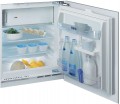Total capacity
The total volume of a refrigerator is the sum of the volumes of all its compartments, which can vary in specific capacity between different models. It's important to consider this when choosing a refrigerator.
A larger volume for a refrigerator can be beneficial for accommodating more food, but it can also increase the price and size of the appliance. This is especially important to consider if you plan to build the refrigerator into a specific space.
Refrigerator capacity
The refrigerating compartment is designed for storage of products that do not require freezing, i.e. cooling down to temperatures below zero. The temperature range inside varies from +2 to +10. In almost all modern refrigerators, it is this compartment that has the largest volume.
To ensure optimal performance and food quality, it's important to choose the appropriate volume for the refrigerating compartment based on your actual food storage needs and how often you replenish your supplies. Overfilling the compartment can have a negative impact on both the refrigerator's performance and the quality of the stored food.
For singles or couples, a refrigerating compartment of up to 200 liters is enough, while families or those who stock up on food should opt for models with up to 400 liters. Vertical refrigerators with separate freezer access are suitable for those who need moderate storage space, while side-by-side refrigerators with their typically larger volumes are a good option for those who require even more space and have ample free space.
Fast cooling
Forced cooling mode is available in some refrigerators, and it significantly increases the cooling intensity of the refrigerator compartment. It's important to note that
fast cooling needs to be turned on and off properly to avoid overloading the compressor. Some models have an automatic shut-off feature, but it's important to check for this feature separately.
LED lighting
The presence of a
LED lighting system in the design of the refrigerator.
LEDs are currently the most advanced type of household lighting due to their high efficiency, providing bright light with low power consumption. They emit minimal heat, making them ideal for refrigerator lighting. Their compact size also allows for even distribution throughout the interior, illuminating all shelves, which is not the case with incandescent lamps that can only shine in one location, leaving some areas poorly lit.
Freezer capacity
The primary function of the freezer is to store food in a state of deep freeze, which helps preserve perishable products such as meat, vegetables, fruits, etc. for extended periods of time. The necessary volume of the freezer depends on the planned amount of food to be stored and the length of time it will be stored. A larger freezer is particularly useful if you plan to store food for several months.
A compact freezer is relevant for short-term storage (for a day or two) or for seasonal devices (for example, in the village). It is best to ensure that the freezer is not overloaded and has enough space for proper circulation of air to maintain the desired temperature.
Autonomy time
Refrigerators with good thermal insulation can maintain low temperatures inside for a significant amount of time even if there is a power outage. This period of time is known as the "keep cold time," during which the refrigerator can preserve perishable food items. A longer keep cold time indicates better thermal insulation, making the refrigerator more suitable for areas where power outages are common.
Freeze capacity
The freezing capacity of a refrigerator refers to the amount of fresh food it can freeze from room temperature to the freezer temperature within a 24-hour period. For everyday use, a freezing capacity of up to 10 kg/day is sufficient, but if you frequently freeze large volumes of food, you should consider a more
powerful freezer.
Controls
Refrigerator control panel. To date, there are such options:
—
Rotary switches. While a rotary switch technically has the potential to be used for a wide range of functions, in practice, this variety is typically only found in basic models with limited functionality. In such cases, control is often done manually by turning a thermostat knob, with limited options for adjusting temperature, humidity, and other settings.
—
Push-buttons. CRefrigerators can have a control panel with classic buttons that offer various functionalities depending on the model. These functionalities can range from basic adjustments (similar to rotary switches) to fine-tuning of temperature and humidity, control of special modes, and more. Compared to rotary switches, push-buttons generally offer a wider range of possibilities.
—
Touch. Touch panels are a modern and stylish control option for refrigerators, which requires a light touch to operate. They are considered the most advanced type of control, providing convenient and extensive functionality. Touch panels are typically installed in premium models, where they add to the device's aesthetic appeal with a minimum of unnecessary protruding parts.
Energy class
The energy class that the refrigerator corresponds to.
Energy consumption classes were originally designated with Latin letters from
A (the most efficient) to D (least efficient), but with technological advancements, more advanced classes such as "A+", "A++", etc. were introduced to indicate increasing levels of efficiency. The more pluses a device has, the more economical it is. This was necessary due to the correlation between energy consumption and decreasing efficiency.
For modern built-in refrigerators, the efficiency indicator at the level of class A can be called average,
A+ — not bad,
A++ — good,
A+++ — excellent. Energy consumption rates B and C are rare and mostly found in outdated or cheaper models. Achieving high efficiency requires design innovations, which results in higher device prices. However, these prices can be justified by the resulting reduction in electricity bills. It's worth noting that some built-in refrigerator models are available in different energy consumption classes, allowing customers to choose the best option for their budget and energy efficiency needs.

